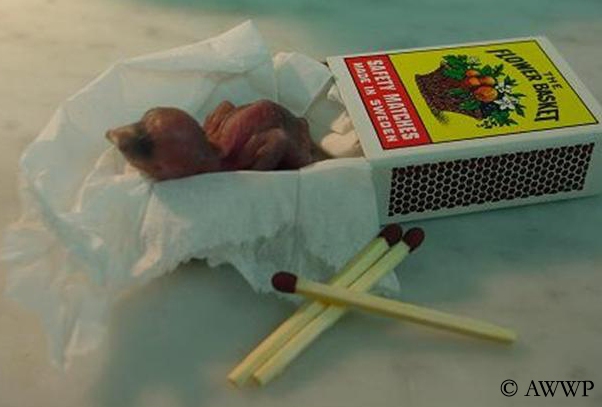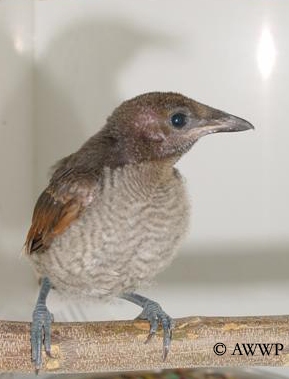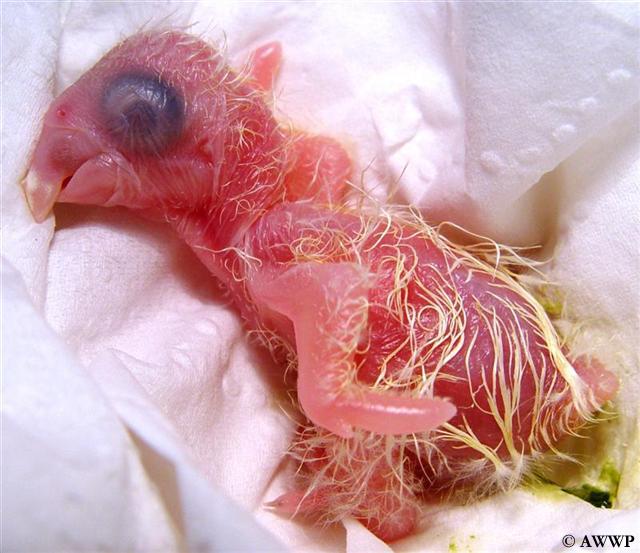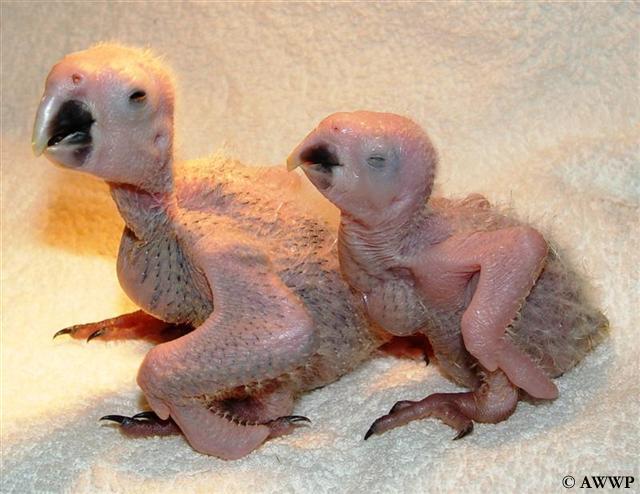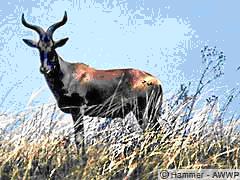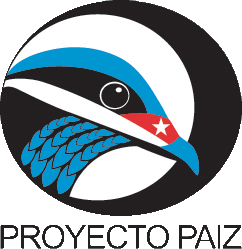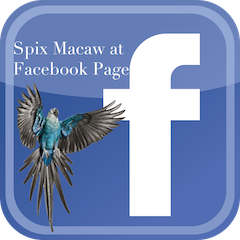King Bird of Paradise
King Bird of Paradise
(Cicinnurus regius)
The newly hatched King Bird of Paradise chick weighs only
4 grams.
Pesquet’s Parrot
PesquetŌĆÖs Parrot
(Psittrichas fulgidus)
January 2005
As the preservationŌĆÖs aim to breed endangered species it achieved its target again in breeding success. The preservationŌĆÖs first PesquetŌĆÖs Parrot chick hatched on the 11th December 2004.

9 days old
The human surrogate parent expresses his warmth affection.

27 days old
At age of 27 days, curiosity is being expressed.

47 days old
Being revealed to its new world.

Age 54 days
Preparing to face the challenging future.
Written By:
Mr. Dean O. Tugade
Assistant Bird Curator
Click here to Contact
Marabou Stork
Marabou Stork
Leptoptilus crumeniferos
(January 2005)
Another anticipated hatch in the Bird Department was the Marabou Storks. From December 2004 to February 2005 2 eye-catching chicks were successfully hand-reared.

Having a pleasant nap waiting for the next meal.

At 16 days old getting a fish treats for lunch.

28 days old attempt to jump out of the box!

30 days old, preparing to stand and walk.
┬Ā
43 days exercising several advanced skills while waiting for breakfast.
Written By:
Mr. Dean O. Tugade
Assistant Bird Curator
Click here to contact
Spix’s Macaw hatching
Spix’s Macaw hatching
(Cyanopsitta spixii)
May 2005)
In the first week of May 2005 another two SpixŌĆÖs Macaw chicks hatched, and are now being handŌĆōreared by the staff at Al Wabra Wildlife Preservation. These two new baby macaws represent an amazing almost 4 % increase in the known world population of their species.
Since year 2000 the SpixŌĆÖs Macaw has been considered to be extinct in the wild. All hope to save the bird species from total annihilation, rest with a very small population kept in captivity.
Sheikh Saoud Bin Mohammad Bin Ali Al-Thani and the Al Wabra Wildlife┬Ā┬ĀPreservation have been dedicated to this species for some years, and have been facing many hurdles in the effort to save the species. These two chicks which are number three and four to hatch under the AWWP management represent super mario world new hope and motivation.
Simon Bruslund Jensen, Curator of Birds

First chick on day 9 just before the eyes start to open.
Stay tuned for updates and new pictures to be downloaded:
|
Chick no. 5158 ŌĆ£MayŌĆØ ŌĆó May 1st: Finally hatches in the afternoon after attempting to hatch for 48 hours in the incubator, slightly assisted. ŌĆó May 9th: Start showing preening behaviour 9 days old ŌĆó May 10th: Eyes start ŌĆ£slittingŌĆØ and the first feather tracts now visible under the skin. ŌĆó May 12th: Pigmentation on feet becomes darker and white stripe on bill starts to develop. ŌĆó May 15th: First pin-feathers break the skin on the back. ŌĆó May 19th: Keeping eyes open for several minutes at the time. |
|
Chick no. 5170 ŌĆ£FerdieŌĆØ ŌĆó May 5th: Hatches without any problems in the incubator in the early morning. ŌĆó May 10th: Pigmentation starts to develop on the bill. ŌĆó May 11th: Preening behaviour observed, 7 days old. ŌĆó May 12th: Eyes start slitting slightly. ŌĆó May 14th: First feather tracts visible under skin. ŌĆó May 16th: Feet start to change color from pink to grey. ŌĆó May 19th: First pin-feathers start to break the skin. |
IMPERIAL AMAZON (2004-2006)
THE IMPERIAL AMAZON, DOMINICA
Popularly known as ├óŌé¼┼ōthe Nature Island of the Caribbean├óŌé¼┬Ø, Dominica is home to two endemic Amazon parrot species, the Imperial Amazon (Amazona imperialis) and the Red-necked Parrot (Amazona arausiaca). The Imperial Amazon, locally known as the Sisserou Parrot, is the national symbol of Dominica and is the largest, and probably the rarest, of the Amazon parrots. A reclusive inhabitant of the montane rainforests on the slopes of the Morne Diablotin volcano in Dominica, the Imperial Amazon was feared to have gone extinct after Hurricane David hit Dominica in 1979. Ever since, the species has been the subject of widespread conservation activities including habitat protection and captive breeding in order to re-establish a self sustaining wild population.
 |
| Imperial Amazon |
AWWP has been involved in capacity building of the local authorities in charge of conservation of the Sisserou. Logistical support for field activities and funding toward the formal training of personnel in endangered species management has been the focus of AWWP├óŌé¼Ōäós initiative. In the near future, a closer collaboration and involvement in the conservation efforts for the Sisserou is envisaged.
Indri
CONSERVATION OF THE INDRIÂ
Madagascar, the fourth largest island in the world, is considered one of the highest priorities for conservation today due to the rich biodiversity and high rate of endemism that the island affords.
The Indri (Indri indri) is the largest of the extant lemur species, revered by the local people for its haunting song-like call. Due to its rapidly disappearing habitat, the Indri today is highly endangered and in need of urgent conservation efforts. Its unique and charismatic appearance, as well as the high level of superstition surrounding the Indri that protects it to some extent from being hunted by the local people, makes it an ideal choice of flagship species for conservation of its habitat as well as other co-existing species.
In January 2008, an evaluation study was carried out by AWWP, in partnership with ACT FOR NATURE (AFN) ├óŌé¼ŌĆ£ a Monaco based conservation organisation with various conservation activities in Madagascar, and their local Madagascan partner- FANAMBY. In keeping with the proposed aims, contact was made with local authorities as well as conservation organisations active at the ground level. Habitat fragmentation as a result of destruction of forest for timber, fuel and clearing for agricultural development appears to be the main threat to the viability of Indri populations in the wild.
The species is notoriously difficult to keep and propagate in captivity, and therefore, in-situ measures such as habitat protection and preservation of corridors linking areas inhabited by these primates is the key to conservation of the species.
 |
 |
| The habitat of the Indri in Andasibe / Perinet Nature Reserve | Team members from AWWP Act For Nature Fanamby |
Related Links:
ACT FOR NATURE www.actfornature.org
FANAMBYwww.fanamby.org.mg
PRINCE RUSPOLI’S TURACO (2003-2006)
┬Ā |
| Prince Ruspoli’s Turaco |
In order to reassess the conservation status of this highly endangered and charismatic species, and to assess the risk of degradation of the genetic pool of the species through introgression of genes of another species, an in-situ research project was initiated by AWWP in 2003 in collaboration with the Ethiopian Wildlife Conservation Organisation (EWCO) in Ethiopia. The project was exclusively funded and coordinated by AWWP through the employment of independent Italian field researcher, Luca Borghesio.
The project, in spite of an abrupt end due to political interventions, culminated in more than 5 major publications on the status of the Prince Ruspoli├óŌé¼Ōäós Turaco, its habitat as well as on other endemic bird species in the region. Moreover, the reassessment confirmed the presence of hybrids, identified hitherto unknown threats to the survival of the species, and formulated recommendations to Birdlife International to elevate the conservation status of the species based on the findings of this study. In addition to detailed data on the Prince Ruspoli├óŌé¼Ōäós Turaco, the project was also able to produce data for publication on the threats to the survival of the endemic Ethiopian Bush Crow (Zavattariornis stresemanni).
┬Ā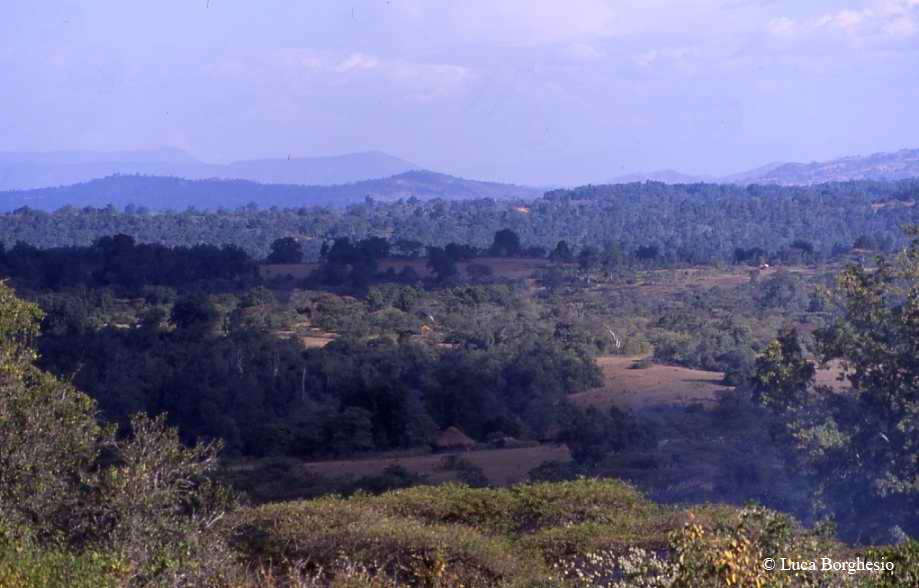 |
| ┬ĀKibre Mengist Forest Ethiopia. |
RELATED PUBLICATIONS
2. The present conservation status of Juniperous forests in the South Ethiopian Endemic Bird Area.┬Ā (187 KB)
3. Al Wabra Wildlife Preservation, Qatar: Working with Turacos Musophagidae spp.┬Ā (3.7 MB BIG FILE!)
4. Habitat degradation threatens the survival of the Ethiopian Bush Crow Zavattariornis stresemanni.┬Ā (177 KB)
5. Publication for AWWP_Website (783 KB)
SWAYNE’S HARTEBEEST (2001-2005)
PROTECTION OF THE SWAYNE’S HARTEBEEST IN SENKELLE, ETHIOPIA
Swayne├óŌé¼Ōäós Hartebeest in Senkelle
SPIX’S MACAW (2007 – )
THE SPIXŌĆÖS MACAW (CYANOPSITTA SPIXII) RECOVERY PROGRAM
In parallel to its captive breeding effort, AWWP is also keen to contribute to in-situ conservation efforts for the SpixŌĆÖs Macaw in Brazil. Towards this end, AWWP has entered into a Memorandum of Understanding to fund captive breeding activities of the Lymington Foundation in Brazil, as well as provide financial support towards an adult education program at the Little Blue School (Spix Macaw school) in Curaca, an institution built to provide primary and secondary education to the people of the region. The latter initiative has been quite successful in not only raising public awareness about the SpixŌĆÖs recovery program, but also in bolstering public opinion in the region for the conservation and future re-establishment of the species.
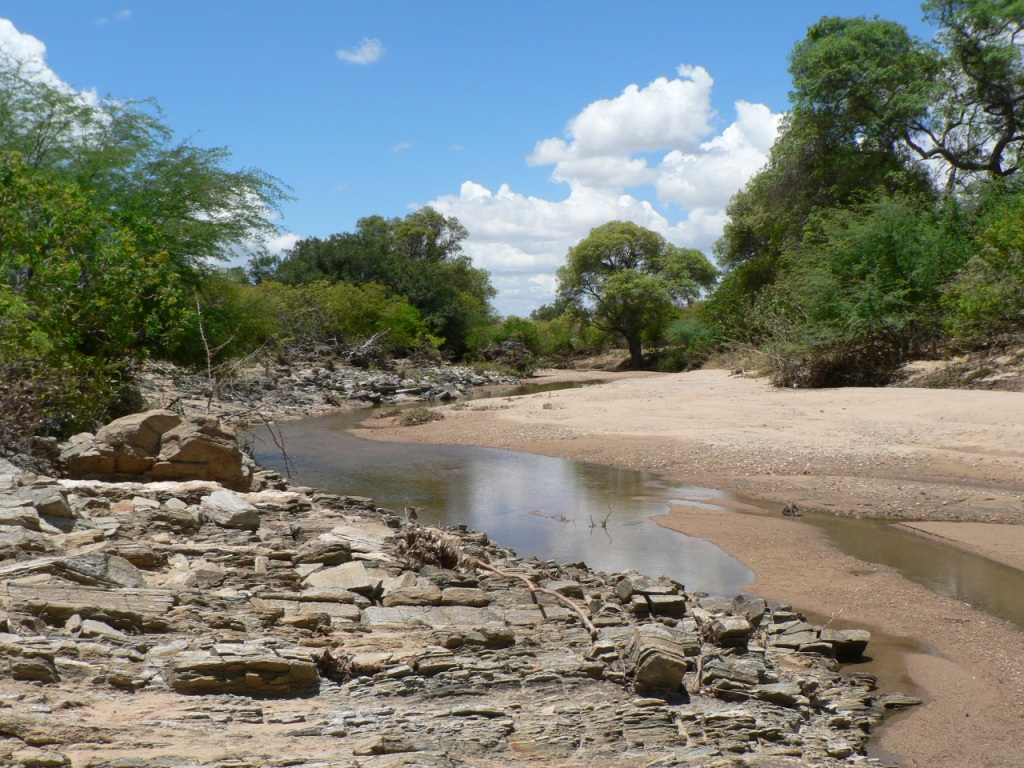 |
 |
| Melancia Creek Gangorra Farm Curaca | Spix’s Macaw Chick age 25 days. |
|
Spixs Macaw School Curaca
|
|
SpixŌĆÖs Macaw Fact File 2009 ŌĆō Portuguese
SpixŌĆÖs Macaw Fact File 2009 ŌĆō English
BLUE HEADED QUAIL DOVE (2005-)
PROTECTION OF THE BLUE-HEADED QUAIL DOVE IN CUBA
Blue-Headed Quail Dove incubating an egg
Proyecto Paiz is a national project of Cuba with the objective to initiate in-situ conservation measures and implement conservation activities for Cuba├óŌé¼Ōäós globally threatened endemic Columbiformes spp. These are
├é┬Ā– The Blue-headed Quail Dove (Starnoenas cyanocephala), a Cuban Ground Dove locally known as Paloma Perdiz, classified as endangered by the IUCN,
├é┬Ā-├é┬ĀThe Grey-headed Dove (Geotrygon caniceps), classified as vulnerable by the IUCN, and├é
├é┬Ā-├é┬ĀThe Plain Pigeon (Columba inornata), also classified as vulnerable by the IUCN but close to being upgraded to endangered status. ├é┬ĀThe Blue-headed Quail Dove is the main focus of the project and forms a flagship species for the conservation of the other less known species.
OBJECTIVES OF PROYECTO PAIZ├é┬Ā
- In-situ protection in selected field sites and protected areas by means of threat mitigation and habitat protection and restoration
- Establishment of a captive population of the Blue-headed Quail Dove for conservation breeding, and
- Increase awareness and education of local people about Proyecto Paiz, thus using the project to heighten interest and awareness of nature conservation and the countries endemic species
The project, after an initial delay due to a long evaluation and permission process from the relevant authorities in Cuba, is now well on its way with a small captive population of 6 Blue-headed Quail Doves housed in the breeding aviaries that have been newly-renovated, under the auspices of Proyecto Paiz, in the protected area ├óŌé¼┼ōSabanas de Santa Clara├óŌé¼┬Ø. At the last update, the birds were showing considerable breeding activity. The project is exclusively funded by the Al Wabra WIldlife Preservation, Qatar.
An Update
As of September, 2008, AWWP, along with it├óŌé¼Ōäós project partners, the ENPFF in Cuba and ZGAP, Germany, is proud to announce the successful breeding in captivity of the population of Blue-headed Quail Doves in Cuba under Proyecto PAIZ.
After an extensive and time-consuming process of registering the project officially with the Cuban government, AWWP funded the travel of Mr. Juan Cornejo, Bird Curator of Africam Bird Safari in Mexico, with the purpose of improving avicultural techniques as well as the captive condition of the birds. In addition to collecting invaluable morphometric data from the birds, new coloured leg bands were used to facilitate easy identification and significant behavioural observations were made which later translated into pairing recommendations for separating the birds. The field coordinators were trained in basic avicultural techniques, providing enrichment, equipping aviaries with artificial nest boxes, and record keeping.
Thereafter, a visit by the AWWP veterinarian and conservation coordinator allowed a basic health evaluation of the birds, carried out with the help of Cuban laboratories as well as the establishment of basic health monitoring and necropsy protocols for birds and eggs. DNA sexing of the birds using feather and blood samples revealed an ideal ratio of 3 males and 3 females in the captive population.
Thereafter, pair separation was done on the basis of DNA tests and behavioural observations, and, in May 2008, the first fertile eggs were laid. The first Blue-headed Quail Dove chick in captivity hatched in June and was successfully parent-reared to fledging. Thereafter, two pairs went on to lay 5 more fertile eggs and from these 4 chicks were successfully reared. The third pair, however, laid a number of infertile eggs.
Currently, Proyecto PAIZ has 5 chicks from this season and 2 fertile eggs in the nests. As a result of a coordinated team effort, the captive breeding of the birds has been a success after 2 years and has resulted in a near doubling of the captive population in a short span of time.
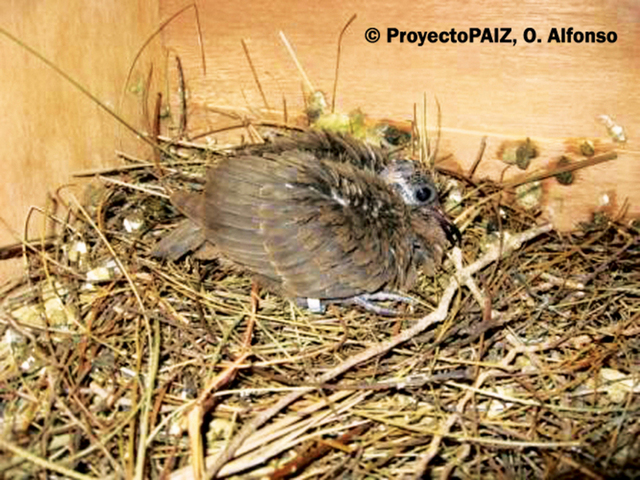 |
 |
| First Blue-headed Quail Dove chick bred in captivity in Proyecto PAIZ. | |

